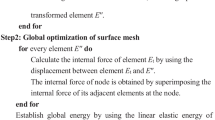Abstract
The problem of optimal surface flattening in 3-D finds many applications in engineering and manufacturing. However, previous algorithms for this problem are all heuristics without any quality guarantee and the computational complexity of the problem was not well understood. In this paper, we prove that the optimal surface flattening problem is NP-hard. Further, we show that the problem of flattening a topologically spherical surface admits a PTAS and can be solved by a (1+ε)-approximation algorithm in O(nlog n) time for any constant ε>0, where n is the input size of the problem.
Similar content being viewed by others
References
Aono M, Breen DE, Wozny MJ (2001) Modeling methods for the design of 3D broadcloth composite parts. Comput-Aided Des 33(13):989–1007
Aona M, Denti P, Breen DE, Wozny MJ (1996) Fitting a woven cloth model to a curved surface: Dart insertion. IEEE Comput Graph Appl 16(5):60–70
Azariadis PN, Sapidis NS (2004) Planar development of free-form surfaces: Quality evaluation and visual inspection. Computing 72(1–2):13–27
Borradaile G, Klein PN, Mathieu C (2007) Steiner tree in planar graphs: An O(nlog n) approximation scheme with singly exponential dependence on epsilon. In: Proc of 10th Workshop on Algorithms and Data Structures, pp 276–287
Garey MR, Johnson DS (1977) The rectilinear Steiner tree problem is NP-complete. SIAM J Appl Math 32(4):826–834
Kim SM, Kang TJ (2003) Garment pattern generation from body scan data. Comput-Aided Des 35(7):611–618
Kobbelt LP, Bischoff S, Botsch M, Kähler K, Rössl C, Schneider R, Vorsatz J (2000) Geometric modeling based on polygonal meshes. Eurographics 2000 Tutorial
McCartney J, Hinds BK, Seow BL (1999) The flattening of triangulated surfaces incorporating darts and gussets. Comput-Aided Des 31(4):249–260
Parida L, Mudur SP (1993) Constraint-satisfying planar development of complex surfaces. Comput-Aided Des 25(4):225–232
Sheffer A (2002) Spanning tree seams for reducing parameterization distortion of triangulated surface. In: Proc of International Conference on Shape Modeling and Applications 2002, pp 61–68
Wang CL, Smith SF, Yuen MF (2002) Surface flattening based on energy model. Comput-Aided Des 34(11):823–833
Wang CL, Wang Y, Tang K, Yuen MF (2004) Reduce the stretch in surface flattening by finding cutting paths to the surface boundary. Comput-Aided Des 36(8):665–677
Author information
Authors and Affiliations
Corresponding author
Additional information
This research was supported in part by the National Science Foundation under Grants CCF-0515203, CCF-0916606.
Rights and permissions
About this article
Cite this article
Chen, D.Z., Misiołek, E. Flattening topologically spherical surface. J Comb Optim 23, 309–321 (2012). https://doi.org/10.1007/s10878-010-9296-8
Published:
Issue Date:
DOI: https://doi.org/10.1007/s10878-010-9296-8



